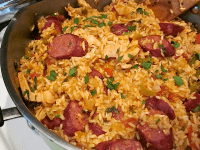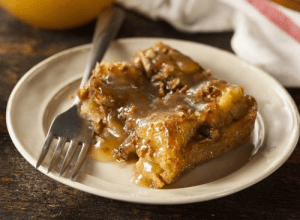 The Cajun Cheesehead Makes Your Life Better,
The Cajun Cheesehead Makes Your Life Better,
by Jack Caldwell
Greetings, everyone. Jack Caldwell here.
The theme for this month is Baking/Recipes/Food. Looks like the Cajun Cheesehead is kicking things off. And why not? This is a favorite subject for anyone from Louisiana. After all, I live in a place that literally lives to eat. We proudly claim some of the best food in the United States. In fact, we have the Great American Cuisine: Creole/Cajun.
So what does this have to do with Jane Austen or the Regency? Well, the Louisiana Purchase happened in 1803, Louisiana became the 18th state in the Union in 1812, and the British tried to take New Orleans (and failed) in 1815. All of this in Miss Austen’s time. So there.
Creole/Cajun is an uniquely American cuisine. It is a true melting pot of differing ingredients, cultures, and styles. You can get it nowhere else on the planet. Unfortunately, our countrymen don’t always understand what Creole & Cajun food really is. There is a lot of very bad Creole & Cajun out there. For your protection, here’s a simple guide to Faux Creole & Cajun food:
- It is spicy hot. Properly prepared Creole & Cajun food is not spicy hot. It is seasoned. By that, I mean we put seasoning other than just salt and pepper in our food, just like in Italian or Chinese food. It’s why our restaurants have hot sauce on the table. The diner chooses how much heat they want in their dish, not the chef.
- It has pepper jack cheese on it. Nothing against pepper jack, but it is not a staple of Creole/Cajun. Pepper jack makes something Tex-Mex in our world.
- It has jalapeños. See above.
- Jambalaya over rice. Wrong! That is not jambalaya. Jambalaya is meat, sausage, and vegetables cooked into rice, much like paella, not a loaded spicy sauce poured over rice. We do have dishes that are similar to what others call “jambalaya”—they are named Sauce Creole, Sauce Piquante, and Etouffee.
- Gumbo is spelled “gumbeaux”. Run away! Run away!
- Okra in everything. Don’t get me wrong—we do like our okra, but we’re not nuts about it.
So, what is Creole/Cajun cuisine? First, they are not the same thing.
 Creole cooking is the food of the city, invented in New Orleans. It is based on the complicated sauces from France. The cooks, mainly former slaves, incorporated the seasonings they knew from the Caribbean and Africa. That’s where the okra came in (although it is not a requirement). Tomato sauce can be used in Creole. Trout Meuniere, Oysters Rockefeller, Gumbo, Eggs Sardou, Red Beans & Rice, Bananas Foster, and Bread Pudding are examples of Creole cooking.
Creole cooking is the food of the city, invented in New Orleans. It is based on the complicated sauces from France. The cooks, mainly former slaves, incorporated the seasonings they knew from the Caribbean and Africa. That’s where the okra came in (although it is not a requirement). Tomato sauce can be used in Creole. Trout Meuniere, Oysters Rockefeller, Gumbo, Eggs Sardou, Red Beans & Rice, Bananas Foster, and Bread Pudding are examples of Creole cooking.
By the way, New Orleans invented the cocktail, but that’s for another posting.
 Cajun cooking is country food. This was invented in the swamps and plains of South Louisiana, mainly by the refugees from Acadia in French Canada. This is one-pot cooking, using whatever was on hand to feed the family. Generally, there is no tomato sauce used. Jambalaya and boiled crawfish are examples of Cajun cooking.
Cajun cooking is country food. This was invented in the swamps and plains of South Louisiana, mainly by the refugees from Acadia in French Canada. This is one-pot cooking, using whatever was on hand to feed the family. Generally, there is no tomato sauce used. Jambalaya and boiled crawfish are examples of Cajun cooking.
Today, there has been some crossover and blending of Creole and Cajun. Blackened Fish is a good example. Others are Creole Jambalaya and Pasta Jambalaya, which include tomato sauce.
The basis of both Creole and Cajun is the Trinity of onion, celery, and bell pepper, plus garlic. This is based on mirepoix (onion, celery, and carrot). The reason we use bell pepper instead of carrot is because carrots did not grow well in Louisiana’s soil. We also use roux (flour and butter or oil) as the main thickener. Rice is our main starch, because we grow it. All kinds of seafood and shellfish, because of the Gulf of Mexico. And, thanks to the Germans who came here, we eat a lot of smoked sausage.
A misconception of Louisiana cooking is that you have to use Louisiana ingredients. Nothing could be further from the truth. Anyone anywhere can cook Creole and Cajun, if they follow some simple rules.
- Creole & Cajun is slow cooking. There is no shortcut. Don’t use a slow cooker—it won’t come out right. Do it the old-fashioned way on the stove. Make your Creole and Cajun dishes on the weekend while you’re watching the game.
- Many dishes require a roux, so learn to make one. It’s a useful skill, for it will make all your soups, stews, and gravies taste better.
- You don’t have to have seafood in every dish. Some time ago, someone—who should live in infamy—invented “Zydeco dishes.” It’s a hodgepodge of seafood (mainly shrimp) mixed with chicken in gumbo and jambalaya. Some folks like it—particularly tourists. I CAN’T STAND IT. Just about all real Louisiana cooking has only one or two proteins in the main dish, and when there are two, one is sausage. My favorite soup is Duck and Andouille Gumbo. We eat a lot of beef, pork, chicken, turkey, duck, and game. So, decide on your protein and don’t mix seafood with non-seafood. Your food will taste better, IMHO.
- Smoked sausage is NOT Italian sausage. That doesn’t mean you have to find Cajun sausage or andouille to make your dishes. Any smoked sausage will do. Polish kielbasa works very well; to be honest, a lot of folks down here love to use it.
- If you don’t like bell pepper, fine—use a mirepoix instead. My wife, for example, can’t stand bell pepper, so I don’t use it.
- Use twice as much garlic as you think you need. Trust me on this.
- We use Worcestershire sauce as a major ingredient. It’s in almost everything.
- If the recipe calls for rice or grits, use it. There’s a reason for it.
- The darker the roux, the more flavor it has, but it loses thickening power. Keep this in mind.
- Throw away your pepper jack. Unless you really, really like it.
- We cook with wine, so use it. But always use wine you would drink. “Cooking wine” will kill you. (Just kidding about that “killing” bit).
 Below is a link to a PDF of three recipes: Chicken Sausage Gumbo, Chicken Sausage Jambalaya, and Bread Pudding with Bourbon Sauce. Yep, they’re my recipes. Like a good Cajun boy, I do all the cooking at the Caldwell house. All are easy to make with ingredients you can find at your local market. My suggestion is to first make them exactly as written, then start playing around with the recipes next time. That way, you’ll make them your own!
Below is a link to a PDF of three recipes: Chicken Sausage Gumbo, Chicken Sausage Jambalaya, and Bread Pudding with Bourbon Sauce. Yep, they’re my recipes. Like a good Cajun boy, I do all the cooking at the Caldwell house. All are easy to make with ingredients you can find at your local market. My suggestion is to first make them exactly as written, then start playing around with the recipes next time. That way, you’ll make them your own!
A couple of notes. Take it easy with the salt. Smoked sausage has a lot of salt in it. Don’t go crazy if you can’t find filé powder for the gumbo. I love it, but your gumbo will be great without it. Alcohol has a taste, so use it. It boils off, anyway—you won’t get drunk.
It’s now time for your questions for the Cajun Cheesehead, so let ’em rip.
Try these Creole & Cajun recipes. They are really easy, I promise. Your life will improve. See why thousands of people flock to the Crescent City each year to eat our food. You just might start using these techniques for your other dishes. In any case, you’ll pass a good time, cher, I guarantee!
Until next time, this has been the Cajun Cheesehead Chronicles.
It takes a real man to write historical romance, so let me tell you a story…

9 comments
Skip to comment form
Hi Jack,
thank you for the recipes!
I love to learn more about food from all over the world.
I’ve never made a pudding before and will try recipe the next days but I am not used to use “cups”. Well, I do have small, large and extra large ones for my tea and hot chocolate 🙂 Can you tell me how much water fits into yours?
And what kind of bread do you use? I am from Germany so there are many different kinds of “bread”. I guess you mean white, soft, toastlike bread?
Thank you!
Author
Thanks for the comment. I forgot that many of our fans are across the water and use metric. So let’s see what we can do. Go here: https://myfrenchchef.com/conversion-chart/
Author
As for bread, you can use soft toasting bread, or French bread, or any bread you like. But Rye and Pumpernickel won’t taste too good. 🙂
Thank you for the recipes. They sound great! I’m a French and as everybody knows a bit fussy about the food we eat 😉. When I read Creole/Cajun food is the best in America, I can’t but give a try at it!
Author
Remember, it’s based on French cooking, so I think you’ll love it!
Thanks Jack. I’ve never cooked a gumbo or jambalaya before so I’m definitely going to try these here in Australia. They should be perfect for the colder weather we’ve got right now.
Author
You should have no troubles, Sarah. Use local ingredients and have fun. Also, there is a link to an imperial-to-metric-conversion-chart above, in case you need it. Thanks!
Thanks for sharing. Your comments are interesting about the mistaken notions about recipes from your area. We have many ethnic groups in this area and so have many restaurants catering to various tastes from sushi to Thai food to Pennsylvania Dutch to Puerto Rican. My mother was from Mississippi and she liked to cook fried chicken just about every Sunday.
Jack, thanks for defining the difference between faux Cajun and the real thing. That has been the problem for myself and many others… getting the bad stuff and not really getting to taste and enjoy authentic cuisine. Next time I see Cajun on the menu… I’ll look at what is in it or at least know the questions to ask my server. Bless you and I wish you much success in your writing. I enjoyed this post.